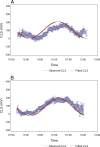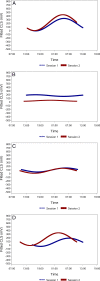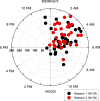Analysis of continuous 24-hour intraocular pressure patterns in glaucoma
- PMID: 23139273
- PMCID: PMC3522433
- DOI: 10.1167/iovs.12-10569
Analysis of continuous 24-hour intraocular pressure patterns in glaucoma
Abstract
Purpose: To present a method to analyze circadian intraocular pressure (IOP) patterns in glaucoma patients and suspects undergoing repeated continuous 24-hour IOP monitoring.
Methods: Forty patients with established (n = 19) or suspected glaucoma (n = 21) underwent ambulatory 24-hour IOP monitoring on two sessions 1 week apart using a contact lens sensor (CLS). The CLS provides its output in arbitrary units (a.u.). A modified cosinor rhythmometry method was adapted to the CLS output to analyze 24-hour IOP patterns and their reproducibility. Nonparametric tests were used to study differences between sessions 1 and 2 (S1 and S2). Patients pursued their routine daily activities and their sleep was uncontrolled. CLS data were used to assess sleep times.
Results: Complete 24-hour data from both sessions were available for 35 patients. Mean (SD) age of the patients was 55.8 ± 15.5 years. The correlation of the cosinor fitting and measured CLS values was r = 0.38 (Spearman r; P < 0.001) for S1, r = 0.50 (P < 0.001) for S2, whereas the correlation between S1 and S2 cosinor fittings was r = 0.76 (P < 0.001). Repeated nocturnal acrophase was seen in 62.9% of patients; 17.1% of patients had no repeatable acrophase. The average amplitude of the 24-hour curve was 143.6 ± 108.1 a.u. (S1) and 130.8 ± 68.2 a.u. (S2) (P = 0.936).
Conclusions: Adapting the cosinor method to CLS data is a useful way for modeling the rhythmic nature of 24-hour IOP patterns and evaluating their reproducibility. Repeatable nocturnal acrophase was seen in 62.9% of patients. (ClinicalTrials.gov number, NCT01319617.).
Conflict of interest statement
Disclosure:
Figures





References
-
- Kass MA, Heuer DK, Higginbotham EJ, et al. The Ocular Hypertension Treatment Study: a randomized trial determines that topical ocular hypotensive medication delays or prevents the onset of primary open-angle glaucoma. Arch Ophthalmol. 2002;120:701–713; discussion, 829–830 - PubMed
-
- Leske MC, Heijl A, Hyman L, et al. Predictors of long-term progression in the early manifest glaucoma trial. Ophthalmology. 2007;114:1965–1972 - PubMed
-
- Whitacre MM, Stein R. Sources of error with use of Goldmann-type tonometers. Surv Ophthalmol. 1993;38:1–30 - PubMed
-
- Liu JH, Kripke DF, Hoffman RE, et al. Nocturnal elevation of intraocular pressure in young adults. Invest Ophthalmol Vis Sci. 1998;39:2707–2712 - PubMed
Publication types
MeSH terms
Associated data
Grants and funding
LinkOut - more resources
Full Text Sources
Medical

